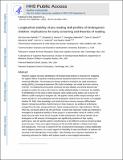| dc.contributor.author | Ozernov-Palchik, Ola | |
| dc.contributor.author | Norton, Elizabeth | |
| dc.contributor.author | Beach, Sara Dawley | |
| dc.contributor.author | Gabrieli, John D. E. | |
| dc.date.accessioned | 2020-08-19T17:52:40Z | |
| dc.date.available | 2020-08-19T17:52:40Z | |
| dc.date.issued | 2017-09 | |
| dc.identifier.issn | 2192-001X | |
| dc.identifier.uri | https://hdl.handle.net/1721.1/126681 | |
| dc.description.abstract | Research suggests that early identification of developmental dyslexia is important for mitigating the negative effects of dyslexia, including reduced educational attainment and increased socioemotional difficulties. The strongest pre-literacy predictors of dyslexia are rapid automatized naming (RAN), phonological awareness (PA), letter knowledge, and verbal short-term memory. The relationship among these constructs has been debated, and several theories have emerged to explain the unique role of each in reading ability/disability. Furthermore, the stability of identification of risk based on these measures varies widely across studies, due in part to the different cut-offs employed to designate risk. We applied a latent profile analysis technique with a diverse sample of 1215 kindergarten and pre-kindergarten students from 20 schools, to investigate whether PA, RAN, letter knowledge, and verbal short-term memory measures differentiated between homogenous profiles of performance on these measures. Six profiles of performance emerged from the data: average performers, below average performers, high performers, PA risk, RAN risk, and double-deficit risk (both PA and RAN). A latent class regression model was employed to investigate the longitudinal stability of these groups in a representative subset of children (n = 95) nearly two years later, at the end of 1st grade. Profile membership in the spring semester of pre-kindergarten or fall semester of kindergarten was significantly predictive of later reading performance, with the specific patterns of performance on the different constructs remaining stable across the years. There was a higher frequency of PA and RAN deficits in children from lower socioeconomic status (SES) backgrounds. There was no evidence for the IQ–achievement discrepancy criterion traditionally used to diagnose dyslexia. Our results support the feasibility of early identification of dyslexia risk and point to the heterogeneity of risk profiles. These findings carry important implications for improving outcomes for children with dyslexia, based on more targeted interventions. | en_US |
| dc.language.iso | en | |
| dc.publisher | Wiley-Blackwell | en_US |
| dc.relation.isversionof | 10.1111/DESC.12471 | en_US |
| dc.rights | Creative Commons Attribution-Noncommercial-Share Alike | en_US |
| dc.rights.uri | http://creativecommons.org/licenses/by-nc-sa/4.0/ | en_US |
| dc.source | PMC | en_US |
| dc.title | Longitudinal stability of pre-reading skill profiles of kindergarten children: implications for early screening and theories of reading | en_US |
| dc.type | Article | en_US |
| dc.identifier.citation | Ozernov-Palchik, Ola et al. “Longitudinal stability of pre-reading skill profiles of kindergarten children: implications for early screening and theories of reading.” Developmental science, vol. 20, no. 5, 2017 © 2017 The Author(s) | en_US |
| dc.contributor.department | McGovern Institute for Brain Research at MIT | en_US |
| dc.contributor.department | Massachusetts Institute of Technology. Department of Brain and Cognitive Sciences | en_US |
| dc.relation.journal | Developmental science | en_US |
| dc.eprint.version | Author's final manuscript | en_US |
| dc.type.uri | http://purl.org/eprint/type/JournalArticle | en_US |
| eprint.status | http://purl.org/eprint/status/PeerReviewed | en_US |
| dc.date.updated | 2019-10-01T13:28:49Z | |
| dspace.date.submission | 2019-10-01T13:28:50Z | |
| mit.journal.volume | 20 | en_US |
| mit.journal.issue | 5 | en_US |
| mit.metadata.status | Complete | |
